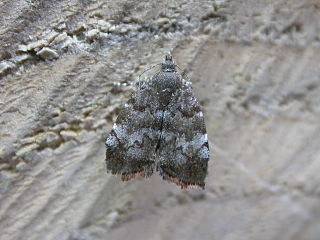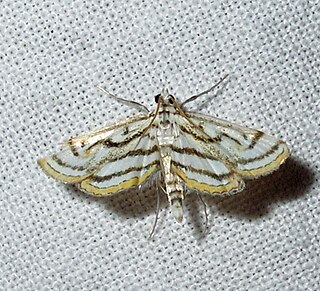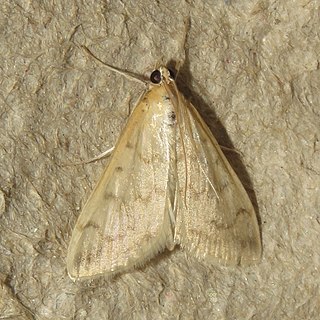Related Research Articles

The cinnabar moth is a brightly coloured arctiid moth found as a native species in Europe and western and central Asia then east across the Palearctic to Siberia to China. It has been introduced into New Zealand, Australia and North America to control ragwort, on which its larvae feed. The moth is named after the red mineral cinnabar because of the red patches on its predominantly black wings. The species was first described by Carl Linnaeus in his 1758 10th edition of Systema Naturae. Cinnabar moths are about 20 mm (0.79 in) long and have a wingspan of 32–42 mm (1.3–1.7 in).

Choreutis pariana, the apple-and-thorn skeletonizer or apple leaf skeletonizer, is a moth of the family Choreutidae. The moth was first described by the Swedish entomologist Carl Alexander Clerck in 1759. It is native to Eurasia and was introduced to New England, USA in 1917.

Parapoynx badiusalis, the chestnut-marked pondweed moth, is a moth in the family Crambidae. It was described by Francis Walker in 1859. It is found in North America, where it has been recorded from Illinois, Indiana, Iowa, Maine, Manitoba, Maryland, Massachusetts, Michigan, Minnesota, Nebraska, New Hampshire, North Dakota, Ohio, Oklahoma, Ontario, Pennsylvania, Quebec, Saskatchewan, Vermont and Wisconsin. The habitat consists of vegetated ponds, marshes and lakeshores.
Parapoynx seminealis, the floating-heart waterlily moth, is a moth in the family Crambidae. It was described by Francis Walker in 1859. It is found in North America, where it has been recorded from Florida, Georgia, Massachusetts, Mississippi, New Hampshire, Rhode Island, South Carolina and Texas.
Haimbachia albescens, the silvered haimbachia moth, is a moth in the family Crambidae. It was described by Hahn William Capps in 1965. It is found in North America, where it has been recorded from Indiana, Iowa, Maryland, New Jersey, West Virginia, Illinois and southern Ontario.

Nemapogon clematella, the barred white clothes moth, is a moth of the family Tineidae. It is found in most of Europe and in North America, where it has been recorded from Maryland and North Carolina. The habitat consists of woodlands.
Hahncappsia alpinensis is a moth in the family Crambidae. It was described by Hahn William Capps in 1967. It is found in North America, where it has been recorded from Arizona, New Mexico and Texas.

Hahncappsia pergilvalis is a moth in the family Crambidae. It was described by George Duryea Hulst in 1886. It is found in North America, where it has been recorded from Ontario and the north-eastern and south-western United States. It is also present in Mexico, where it has been recorded from the Federal District, Puebla and Jalisco.

Pyrausta rubricalis, the variable reddish pyrausta moth, is a moth in the family Crambidae. It was described by Jacob Hübner in 1796. It is found in North America, where it has been recorded from Illinois to New York, south to Florida and Louisiana. It is also reported from the west coast, from southern California to Washington. The wingspan is about 15 mm and adults have been recorded on wing from March to October.
Rhectocraspeda periusalis, the eggplant webworm moth, is a moth in the family Crambidae. It was described by Francis Walker in 1859. It is found in the West Indies and from the United States, where it has been recorded from Florida, North Carolina, Ohio, Oklahoma, South Carolina and Tennessee, south through Mexico and Central America to South America, including Ecuador, Brazil, Guyana, Trinidad and Tobago and Suriname.

Frechinia helianthiales is a moth in the family Crambidae. It was described by Mary Murtfeldt in 1897. It is found in North America, where it has been recorded from Arizona, Illinois, Manitoba, Missouri and Oklahoma, south to Mexico.
Frechinia lutosalis is a moth in the family Crambidae. It was described by William Barnes and James Halliday McDunnough in 1914. It is found in North America, where it has been recorded from Arizona, Colorado and New Mexico.
Microtheoris vibicalis, the whip-marked snout moth, is a moth in the family Crambidae. It was described by Zeller in 1873. It is found in North America, where it has been recorded from Kansas, New Mexico, Oklahoma and Texas.
Apilocrocis pimalis, the Pima apilocrocis moth, is a moth in the family Crambidae. It was described by William Barnes and Foster Hendrickson Benjamin in 1926. It is found in North America, where it has been recorded from Arizona and Texas.

Diastictis argyralis, the white-spotted orange moth, is a moth in the family Crambidae. It was described by Jacob Hübner in 1818. It is found in North America, where it has been recorded from Colorado, Florida, Georgia, Indiana, Maine, Maryland, Mississippi, North Carolina, Ohio, Ontario, South Carolina, Tennessee, Texas and Virginia.

Glyphodes pyloalis, the lesser mulberry snout moth, lesser mulberry pyralid or beautiful glyphodes moth, is a moth in the family Crambidae. It was described by Francis Walker in 1859. It is found in Iran, China, Japan, India, Indonesia (Sumatra), Sri Lanka, Taiwan, the Democratic Republic of the Congo, Equatorial Guinea, Mozambique and North America, where it has been recorded from Florida, Maryland, North Carolina, South Carolina and Virginia.
Mecyna submedialis, the orange-toned mecyna moth, is a moth in the family Crambidae. It was described by Augustus Radcliffe Grote in 1876. It is found in North America, where it has been recorded from Ontario and Michigan, south to Florida and west to Arkansas. It has also been recorded from Alberta.

Palpita freemanalis, or Freeman's palpita moth, is a moth in the family Crambidae. It was described by Eugene G. Munroe in 1952. It is found in North America, where it has been recorded from Alabama, Illinois, Indiana, Louisiana, Maryland, Mississippi, North Carolina, Oklahoma, South Carolina, Tennessee and Texas.
Palpita illibalis, the inkblot palpita moth, is a moth in the family Crambidae. It was described by Jacob Hübner in 1818. It is found in North America, where it has been recorded from Alabama, Florida, Georgia, Maryland, Mississippi, North Carolina, Ohio, Oklahoma, Pennsylvania, South Carolina, Tennessee, Virginia and West Virginia.
Penestola bufalis, the black penestola moth, is a moth in the family Crambidae. It was described by Achille Guenée in 1854. It is found in the US states of Texas and Florida, as well as on the Antilles. It is an accidentally introduced species on the Galápagos Islands. The habitat consists of coastal mangrove swamps and shorelines.
References
- ↑ Nuss, M.; et al. (2003–2014). "GlobIZ search". Global Information System on Pyraloidea. Retrieved 2014-07-15.
- ↑ Moth Photographers Group. Mississippi State University.
- ↑ Proceedings of the United States National Museum 120 (3561)
- ↑ BugGuide